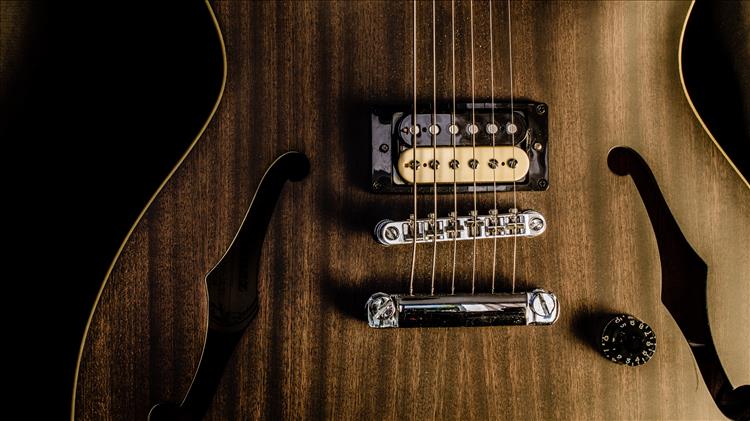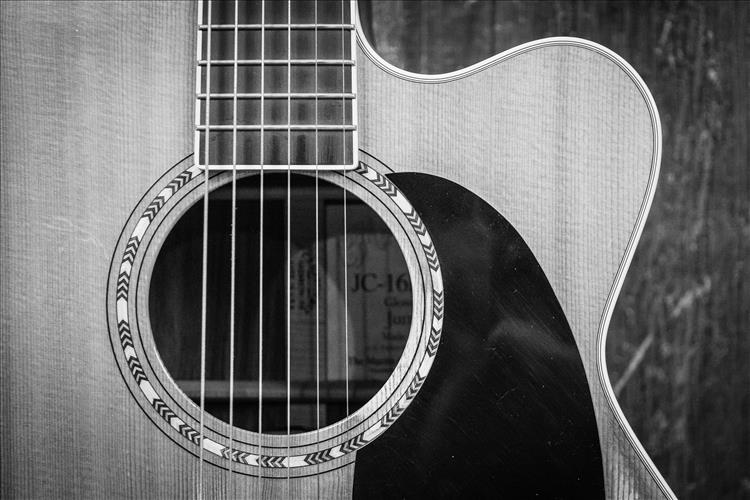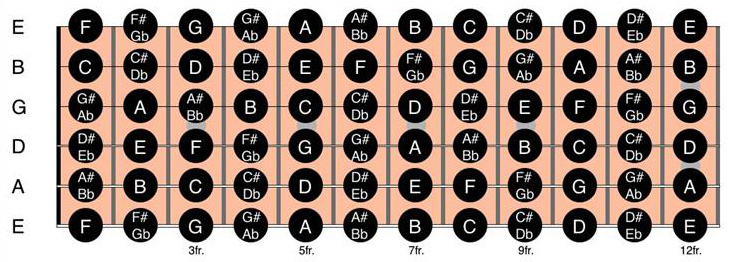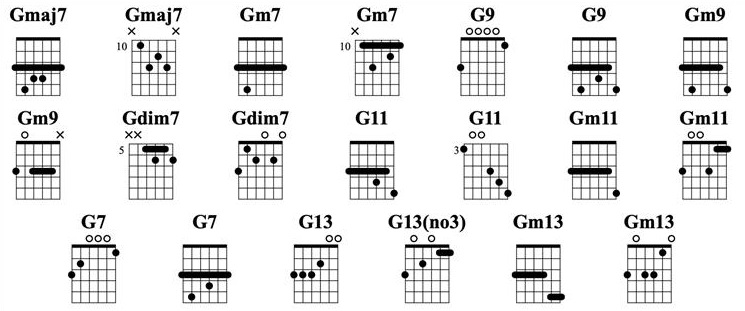Jazz chords can add new flavours to our guitar playing – Let’s find out how!
Over 100,000 guitar-learners get our world-class guitar tips & tutorials sent straight to their inbox: Click here to join them
In this free lesson you will learn…
- 10 Easy Jazz Chords – Two shapes per chord
- Tips for better playing
- How jazz chords are built
- Some great Jazz musicians to check out!
Jazz Chords Can Spice Up Our Playing In New Ways
Throughout our guitar journey, we will come across a never-ending variety of chords that will test the limits of our fingers and ears.
One of the most interesting categories of guitar chords are Jazz chords.
- These chords possess more detail than your run-of-the-mill guitar chord, and can add beautiful voicings to our chord progressions.
- In this free guitar lesson, we’re going to dive deep on Jazz chords to find out how they work, how to play them, and what they sound good with.
We’re also going to name-drop a fair amount of notable Jazz guitarists and musicians that are definitely worth checking out. After all, no guitar lesson is complete without a little listening!
We’re going to jump straight in and look at the differences between Jazz chords and other chords. Let’s go!
How Are Jazz Chords Different From The Chords We Already Know?
The answer to this question is in the details.
- Jazz musicians use chords a lot more expressively than your regular pop musicians would.
- Jazz chords are used as a means of moving a song along in a very direct way.
- Often times, guitarists will switch keys from one chord to the next in order to create very specific types of harmonic movement.
Due to the fact that these chords use different types of note combinations (and often more notes) than your regular open-position chords, Jazz chords tend to be more expressive and moody as a result.
This isn’t a bad thing though – This just means we need to learn how to use them properly!
We’re not going to talk about how to change keys today, but we are going to talk about what Jazz chords work well together to give you some insight into how they function.
Now, let’s chat about why these types of guitar chords are so important!
Learn 12 EASY beginner chords with our popular guide

✅ Stop struggling. Start making music.
✅ Learn beginner-friendly versions of every chord.
This is our most popular guide and it will improve your chord ability quickly! 😎
Get your own personalised guitar-learning plan 🎸
Get a custom guitar-learning plan here: Click here for GuitarMetrics™
World-Class Guitar Courses 🌎
Learn from the world's best guitar educators: Click here for our guitar courses
Why You Should Be Learning Jazz Chords
This variety of guitar chord allows for a lot more expression than our regular major and minor chords.
- With Jazz chords, we can set ourselves up to use very specific types of scales over the progressions we write.
- This is ideal for the guitarist who wants to write pointed and intricate music. A great example of a Jazz guitarist with amazing chops is Alan Holdsworth.
Holdsworth prided himself on using a vast and unique variety of Jazz chords in his playing, and this gave him a very distinct sound that is easy to pick out in the Jazz world.
Check out his music here.
Pro Tip: For this lesson, we are going to stick to the key of G. Staying in one key will help us hear all of the differences in each of the chords we learn to play.
Be sure to keep a pencil handy nearby to write these chord formations down!
- Using one key to learn a handful of chords makes your life a lot easier than learning different chord shapes in different keys first.
- Practicing jazz chords in this way lets us see how each chord form differs from the next by comparing their note combinations.
Keep this in mind when learning new chords!
Now let’s have a look at major and minor 7th chords!
Jazz Chords: Major & Minor 7th Chords
These chords are the bread and butter of Jazz music.
- Before we learn any other Jazz chords, we should start with these. The reason for this is that they help to define the Jazz sound and distinguish it from other genres of music.
- This isn’t to say that these chords don’t exist in other genres of music – They do.
However, they are more prominently used in Jazz.
- Major 7th chords are composed of the same I, III & V notes that we see in any other major chord, but with the addition of the VII (7th) note as well.
- This ‘major 7th’ note colours our major chord differently, adding a lush and smooth texture on top of an already beautiful chord.
- Our major 7th note occurs at the 4th fret (D string) in our first example, and our 11th fret (G string) in the second example.
You’re going to need to bust out the barre for these Jazz chords:
The minor 7th chord is similar in its construction – Possessing the same I, bIII & V of our basic minor chord with the addition of a bVII note to add the ‘Jazz sound’ to the mix.
Our minor 7th note occurs at the 3rd fret (D string) in our first example, and at the 10th fret (G string) in our second example.
Pro Tip: We’ve included a fretboard map further down in the article to help give you reference to what notes you are playing, and where else you can play them.
You can find multiple instances of these Jazz chords all across the fretboard!
How many can you find?
Pro Tip: Jazz music typically does not make use of your traditional and standard chord types.
Instead, these ‘basic’ chord shapes are (almost) always swapped for 7th chords to provide the song with more colour.
Try This: Take any chord progression you already know and swap your chord shapes for Jazz chords like these. You’ll notice a huge shift in the tone of the song you play.
Jazz Chords: Major & Minor 9 Chords
Writer’s Note: As you progress on your guitar journey, you will notice that you may develop unique words to describe the chords you play and the songs you write.
I’ve always used the term ‘flowery’ to describe major 9 chords. As we pair this type of chord with other chords, we will notice is take shape and ‘bloom’ in different ways.
- This is a chord that can move to many different places, and we highly recommend experimenting with it to get the most out of it!
- The major 9 chord is most easily played from the A string to the B string, as illustrated below.
- This chord is composed of the first, second, third, fifth and seventh notes of the major scale.
For this example, we’re going to play it without the fifth note.
Play it below:
The minor 9 chord not only adds its own brand of colour to the mix, but it also pairs extremely well with the major 9 chord.
Try This: Play your major 9 chord at the 8th fret on the A string (F), then play your minor 9 chord at the 5th fret on the A string (D). This is a reliable and gorgeous chord combination that works pretty well anywhere, in either major or minor keys.
Use your index finger for the stretch backward on the D string, and your middle finger on the A string. Your ring and pinky will take care of the G and B strings. Give it a shot below!
Pro Tip: The ‘9th’ in these chords is actually the 2nd note in the scale up one octave. Due to the fact that there are seven notes in the major scale, we are technically adding seven notes to the 2 to raise it up an octave – hence the 9. Now you know!
Jazz Chords: Half-Diminished Chords
Half-diminished chords give a shroud of darkness and confusion to our chord progressions. An interesting point about these chords is that they technically lead nowhere, which means that they can move anywhere.
Half-diminished chords don’t pop up naturally in major and minor scales like 9th chords do, but they can be easily found in the harmonic minor scale – Spanish Guitar Scales – An Essential Guide
Pro Tip: A half-diminished chord can be played at multiple points across one set of strings. Every three frets, the order of notes recycles itself to form the same chord with a different order of notes.
Try This: Play a half-diminished chord at the 6th fret on your D string (G#), then play an Am chord.
- Play that same half-diminished chord three frets up at the 9th fret (B), then play a C major chord.
- Do you hear how these jazz chords move effortlessly to each chord?
- This is because we are resolving these jazz chords a half-step up (G# – A, B – C)
Pro Tip: These chords are often written as ‘dim7’.
Have a look at the fretboard below to see where else you can play these handy jazz chords.
Jazz Chords: 11th Chords
11th chords are majestic and other-wordly in their sound, and the minor and major varieties are able to work together quite easily.
- Major 11th chords are rich sounding, and require us to use barre chords to achieve their most complete sound.
- To make things easier, use your middle finger on the G string and your pinky finger on the high E string for additional reach.
Try on a major 11th chord below:
Minor 11th chords are just as fascinating as their major cousins, and the two tend to compliment each other well in most musical settings.
- A minor 11th chord is super easy to play if you’re familiar with barre chords and how to play them.
- You can use either your pinky or ring finger on the high E string to reach the last note – whatever is more comfortable for your hands.
Try This: Play a G major 11 chord at the 3rd fret on your E string, then move up two frets and drop your middle finger to play an A minor 11 at the 5th fret.
Jazz Chords: Dominant 7 Chords
Dominant 7 chords rule the world of Jazz chords – plain and simple.
- Everyone from Miles Davis to Guthrie Govan have made excessive use of these chords in their compositions, and for good reason.
- Dominant 7 chords contain a lot of definition and structure that help support the harmonic motion of common Jazz songs.
When we write these chords, we simply write the root note and ‘7’.
Ex: G7 below:
A dominant 7 chord is a major chord with a minor 7th note. This means that instead of a regular 7 note, we flatten the 7th note.
The notes of the G7 chord are:
G | B | D | F
Pro Tip: You may notice that most of these chords contain four notes as opposed to the typical three that we are used to seeing.
The addition of a fourth note to our chord shapes adds new colour and expression to chords that we are already familiar with.
Want to add some spice to your chord shapes? Add another note!
Download our lead guitar cheat-sheet to make things easier
It's hard to understand which scales work with which keys.
So we created a cheat-sheet! A key and scale-finder that you can use again and again.

Get your personalised guitar-learning plan 🎸
Get a custom guitar-learning plan here: Click here for GuitarMetrics™
World-Class Guitar Courses 🌎
Learn from the world's best guitar educators: Click here for our guitar courses
Jazz Chords: 13 Chords
Another mysterious-sounding chord with a lot of character, 13 chords are mood-setting chords that can add some spice to our chord progressions.
- If you’re this far along, then chances are you’ve gotten a pretty good grip on barre chords by now.
- The 13 note is simply our sixth note of the major scale raised up one octave in similar fashion to our 9th chords.
Listen: Charlie Christian was hailed as one of the Jazz world’s great young guitar players. His use of unique chord structures and guitar phrasing made him a memorable name with a distinct approach to Jazz chords and guitar. Listen to his rendition of the Jazz standard ‘Rose Room’ here.
Pro Tip: Many of the chords you will see in this lesson are scaled back to accommodate the guitar’s six strings. As we get into larger chord shapes, we may have to omit some notes.
Piano players are able to play larger stretches of chords because they have no string limitations, but we as guitarists have to make due with what we have.
- The easiest notes to omit from a chord in order to make room for the ‘defining notes’ (like 9s and 13s) are our 3s and 5s.
- In the case of a G major chord, our 3 would be B and our 5 would be D.
- In the case of a G minor chord, our 3 would be Bb and our 5 would be D.
Pro Tip: Check out the chord charts for all of the chords you learned today below, and have a look at this article for more jazz chords!
Where Do I Go From Here?
Want more out of these amazing jazz chords? We recommend:
- Break down more of the theory of these chords to understand how they function with different scales
- Write a song using some of these chords
- Practice soloing over these chords with different scales
- Purchase a copy of the Real Book to start learning Jazz standards!
- Pick up Joe Pass’ Guitar Chords Book here
Recommended Resources
If you enjoyed this lesson on Jazz chords, we’ve got some other great content lined up for you below:
- 6 Jazz Guitar Scales Every Advanced Guitarist Must Know
- Jazz Guitar Lessons
- 10 Guitar Tips I Wish Someone Taught Me
- Free Guitar Lessons
- Electric Guitar Lessons – How To Sound Like A Rockstar
What Type of Guitarist Are You?
Take our 60-second quiz & get your results: Take The Quiz
Join the world's best online guitar school 🌎
- Get your own personalised guitar learning plan (customised just for YOU).
- World-class online guitar courses. Learn at your own pace.
- Community Campus & Learning Forum - A friendly community! Connect with our team & students. 😊
- Beginner Song library with chordsheets, tabs and tips. (Songs suitable for all levels!)
- Regular live streams, seminars and Q&A sessions - Learn from world-class guitar educators. Get all your questions answered!
Click here to learn more about National Guitar Academy membership 
Cool Guitar T-shirts 😎
Look cooler! Check out our merch: Click here to see our merch store
Want free guitar tips and video lessons delivered to your inbox?
Join over 100,000 guitar-learners and subscribe to our guitar-tips-by-email service. (It's free.)
We'll send you a series of lessons that will move you to the next level of your guitar journey.
Learn how everything fits together quickly, easily and effectively. We share ninja tips (for instant fun!) but also timeless fundamentals that will deepen your understanding.

Popular Lessons
How To Learn Guitar: An 11-Step Programme For Beginners
How To Choose The Perfect Beginner Guitar
More Cool Guitar Stuff
Learn about National Guitar Academy: About Us
Join us on Facebook for daily guitar tips.
Listen to our Learn Guitar Podcast for rapid guitar progress.
Check out our free chord lessons.
Get our best guitar tips & videos
Where should we send it?
Where should we send it?
Get our best guitar tips & videos


















